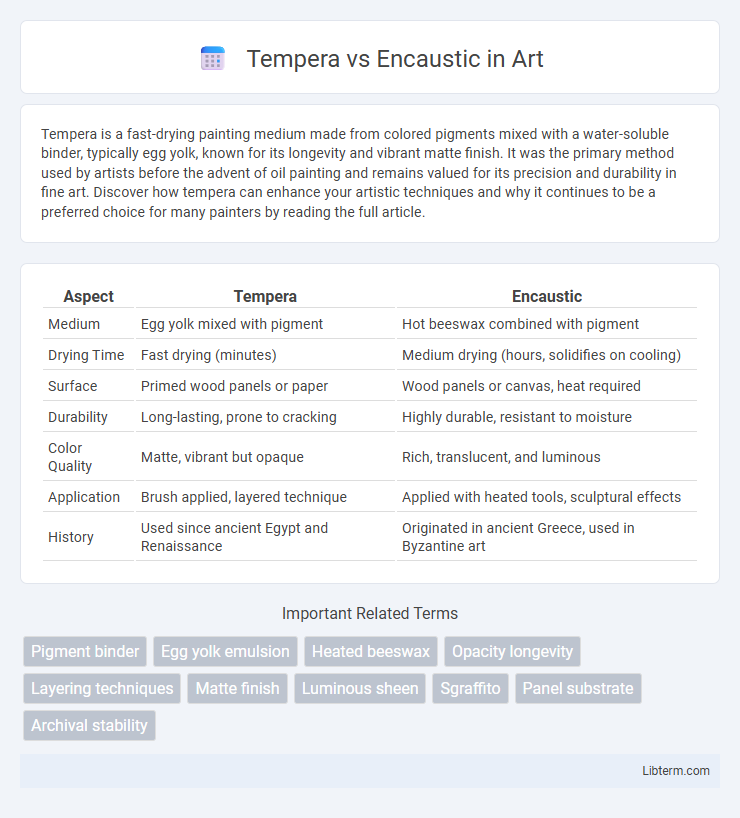Tempera is a fast-drying painting medium made from colored pigments mixed with a water-soluble binder, typically egg yolk, known for its longevity and vibrant matte finish. It was the primary method used by artists before the advent of oil painting and remains valued for its precision and durability in fine art. Discover how tempera can enhance your artistic techniques and why it continues to be a preferred choice for many painters by reading the full article.
Table of Comparison
| Aspect | Tempera | Encaustic |
|---|---|---|
| Medium | Egg yolk mixed with pigment | Hot beeswax combined with pigment |
| Drying Time | Fast drying (minutes) | Medium drying (hours, solidifies on cooling) |
| Surface | Primed wood panels or paper | Wood panels or canvas, heat required |
| Durability | Long-lasting, prone to cracking | Highly durable, resistant to moisture |
| Color Quality | Matte, vibrant but opaque | Rich, translucent, and luminous |
| Application | Brush applied, layered technique | Applied with heated tools, sculptural effects |
| History | Used since ancient Egypt and Renaissance | Originated in ancient Greece, used in Byzantine art |
Introduction to Tempera and Encaustic Painting
Tempera painting, known for its use of egg yolk as a binder, produces a luminous, matte finish that has been favored since the early Renaissance for its fast-drying and durable qualities. Encaustic painting, employing heated beeswax mixed with colored pigments, allows for rich texture and vibrant colors that can be layered or sculpted, offering a versatile medium dating back to ancient Egypt. Both techniques require precise application methods and offer distinct aesthetic results, making them unique choices for artists exploring traditional painting styles.
Historical Background of Tempera and Encaustic
Tempera, originating in ancient Egypt and flourishing during the Middle Ages and Renaissance, involves pigment mixed with a water-soluble binder like egg yolk, producing fast-drying, durable artworks prevalent in religious iconography and panel painting. Encaustic, dating back to ancient Greece and Rome, employs heated beeswax combined with colored pigments, allowing artists to create richly textured, luminous surfaces that have preserved well over centuries. Both techniques significantly influenced art history, with tempera dominating early European painting and encaustic admired for its vibrant, long-lasting qualities.
Composition and Materials Used
Tempera paint is composed of pigment mixed with a water-soluble binder, usually egg yolk, which creates a fast-drying, matte finish ideal for fine detail and precision. Encaustic uses pigments suspended in hot beeswax combined with resins, allowing for rich texture and vibrant, translucent layers that can be sculpted or manipulated while warm. The contrast in binders--egg yolk versus molten wax--defines the durability, application techniques, and final visual effects of each medium.
Distinct Techniques and Application Methods
Tempera painting employs pigment mixed with egg yolk as a binder, creating a fast-drying medium ideal for fine detail and smooth, opaque layers on rigid surfaces like wood panels. Encaustic uses heated beeswax combined with pigment, applied in molten form and fused with heat to achieve rich texture, luminosity, and durable, layered effects on rigid supports such as wood or canvas. While tempera demands precise brushwork and thin, controlled strokes, encaustic allows for sculptural buildup, scraping, and polishing, offering a tactile and versatile application method.
Visual Characteristics and Aesthetic Effects
Tempera produces matte, opaque surfaces with fine, smooth details and crisp lines due to its fast-drying water-based medium, creating vibrant but controlled color effects. Encaustic, made from pigmented hot wax, offers a luminous, translucent quality with rich textures and depth, allowing for layering and sculptural surface variations that enhance dimensionality. The visual contrast between tempera's flat precision and encaustic's tactile, glowing surfaces defines their distinct aesthetic appeals.
Durability and Preservation Differences
Tempera paint, composed of pigment mixed with egg yolk, is known for its longevity but tends to be more fragile and susceptible to cracking over time due to its brittle nature. Encaustic painting, which uses heated beeswax mixed with colored pigments, offers superior durability and resistance to moisture and environmental damage, making it highly prized for preservation. Unlike tempera, encaustic surfaces can be easily restored by reheating and fusing the wax layers, ensuring long-term stability and vibrancy of the artwork.
Typical Subjects and Artistic Uses
Tempera painting, known for its fine detail and vibrant colors, is typically used for portraits, religious iconography, and intricate panel paintings due to its fast-drying and precise application properties. Encaustic art, employing heated beeswax mixed with pigments, excels in creating textured surfaces and is often used for abstract compositions, landscapes, and figurative works that benefit from its luminous depth and durability. Both mediums offer distinct artistic uses, with tempera favoring detailed, controlled imagery and encaustic emphasizing tactile, layered effects.
Advantages of Tempera Over Encaustic
Tempera paint offers faster drying times compared to encaustic, enabling quicker layering and detail work ideal for fine art techniques. Its water-based formulation allows easy cleanup and safer handling, unlike encaustic's hot wax medium that requires heating equipment and careful temperature control. Tempera provides precise control and vibrant, matte finishes that resist yellowing, making it a durable choice for long-lasting artworks.
Advantages of Encaustic Over Tempera
Encaustic painting offers superior durability and color vibrancy compared to tempera due to its wax-based medium, which resists cracking and fading over time. The encaustic technique allows for rich texture and layering, enabling artists to create more depth and complexity in their work. Encaustic paint is also water-resistant once cured, providing enhanced longevity and preservation advantages over the water-soluble tempera medium.
Choosing the Right Medium for Your Art
Tempera offers a fast-drying, vibrant finish ideal for fine detail and precise layering, making it perfect for traditional and illustrative artworks. Encaustic, with its wax-based texture and rich, glossy surface, provides depth and longevity, suitable for textured, expressive pieces that require dimensionality. Selecting the right medium depends on your desired finish, working time, and textural preferences in your artistic expression.
Tempera Infographic

 libterm.com
libterm.com